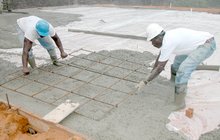Concrete
|
|
This article is about the construction material. For the philosophical term, see Concrete (philosophy). For the comic book, see Concrete (comics).
Concrete_pouring_0020.jpg
for a commercial building
In construction, concrete is a composite building material made from the combination of aggregate and cement binder. The most common form of concrete is portland cement concrete, which consists of mineral aggregate (generally gravel and sand), portland cement and water. It is commonly believed that concrete dries after mixing and placement. Actually, concrete does not solidify because water evaporates, but rather cement hydrates and eventually hardens into a stone-like material. When used in the generic sense, this is the material referred to by the term concrete. Concrete is used to make sidewalks, building foundations, freeways, overpasses, parking structures, bases for gates/fences/poles, and cement in brick or block walls. An old name for concrete is liquid stone.
The Assyrians and Babylonians used clay as cement in their concretes. The Egyptians used lime and gypsum cement. In the Roman Empire cements made from pozzolanic ash were used to make a concrete very similar to modern portland cement concrete. In 1756, British engineer John Smeaton pioneered the use of portland cement in concrete, and used pebbles and powdered brick as aggregate. In the modern day, the use of recycled/reused materials as concrete ingredients are gaining popularity due to increasingly stringent environmental legislation. The most conspicuous of these are pulverized fuel ash (pfa), recycled from the ash by-products of coal power plants. This has a significant impact in reducing the amount of quarrying and the ever attenuating landfill space.
Concrete_pumper.jpg
Concrete has great compressive strength, but little tensile strength, resulting in cracks. To overcome this limitation, concrete is most often constructed with the addition of steel or fiber-reinforced plastic reinforcement. The reinforcement can be by bars (rebars), mesh, cables, or fibres to produce reinforced concrete. Concrete can also be prestressed, allowing for beams or slabs with a longer span than is practical with reinforced concrete.
Certain shapes are very strong in compression, such as arches and vaults, and are therefore preferred for concrete construction.
Concrete is also made with asphalt or epoxy as a binder.
Slump
Concrete slump is determined by using a standard 12-inch high slump cone, into which concrete is placed for testing. When the cone is carefully lifted off the enclosed material, it will slump a certain amount due to its water content. A relatively dry sample will slump very little, and be given a slump of one or two inches, while a relatively wet concrete sample may slump as much as six or seven inches. Those with experience in delivering, mixing, and handling concrete can estimate the slump with a glance. To increase the slump one inch, the rule of thumb is to add one gallon of water to each cubic yard of concrete in the mixer truck. Adding 27 gallons to nine yards of batched concrete will therefore increase the slump by about three inches.
See also
External link
- History of Concrete (http://inventors.about.com/library/inventors/blconcrete.htm)bg:Бетон
da:Beton de:Beton et:Betoon es:Hormigón eo:Betono fr:Béton nl:Beton ja:コンクリート no:Betong pl:Beton pt:Concreto (material) ru:Бетон sl:Beton sv:Betong zh:混凝土

